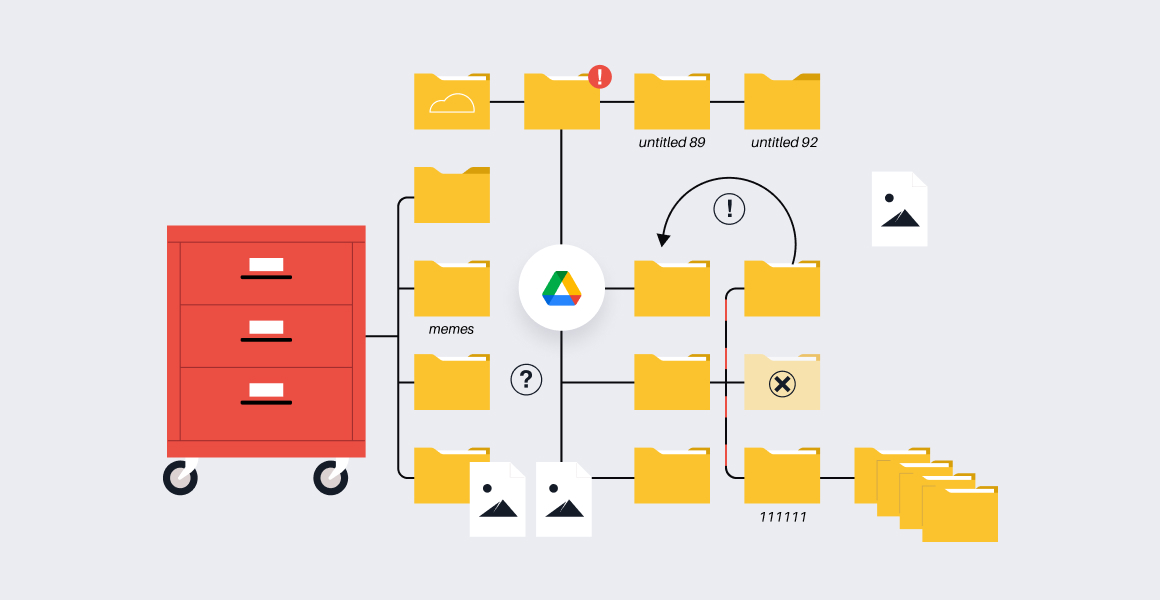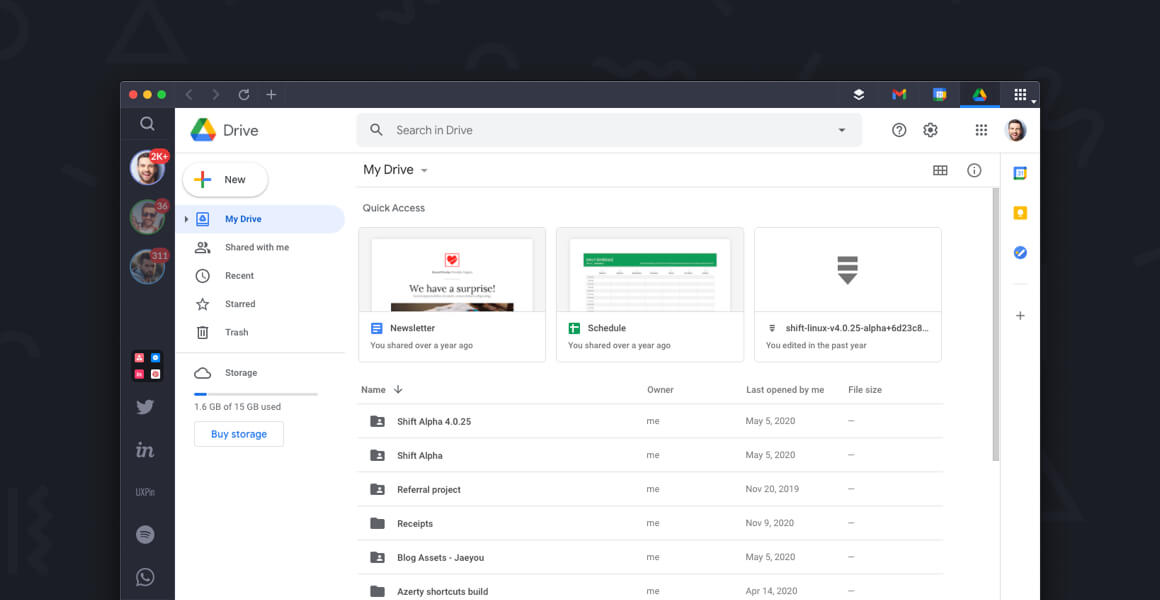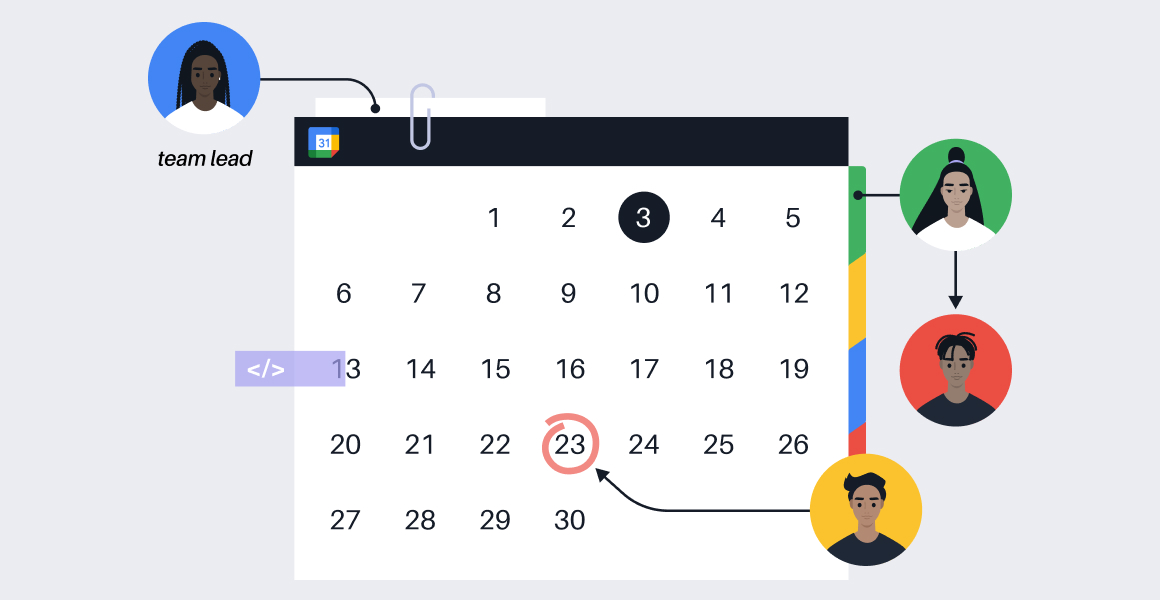Google is a powerhouse in digital platforms. Many people think of Google as a simple search engine, but the brand has gone far beyond that. Along with the search engine, over the years Google has introduced an email provider, bought YouTube and Android, and created a suite of products for working online. Google Drive is just one element of the plethora of digital solutions Google offers.
According to Google, Drive is “a file storage and synchronization service developed by Google. Launched on April 24, 2012, Google Drive allows users to store files in the cloud, synchronize files across devices, and share files.” It’s essentially a free cloud-based storage service that enables users to store and access files online. All Google Drive users receive 15 gigabytes of free storage across Gmail, Google Drive and Google Photos (though more space can be purchased on other plans). Users love the platform because they can store their files securely and open or edit them from any device using Google Drive. Plus, Drive integrates with Docs, Sheets, and Slides, cloud-native collaboration apps that enable teams to create content and collaborate more effectively. Google has also prioritized data security and privacy, which are real concerns in today’s digital landscape. This means users can feel comfortable using Google Drive for any of their personal or professional needs.
Like any digital platform, Drive is always evolving and there are always things to learn. Whether you are a Google Drive power user, or just dabble in the product, chances are there is more you can be doing to make the most of the tools available. Here, our productivity experts have compiled some of their favorite tips for maximizing time and efficiency using Google Drive.
Related Article: How to Get a Google Drive App for Desktop
Store versatile files
Some people think that Drive can only hold certain types of files, or that Drive is designed for Google items like Sheets only. However, any type of file can be uploaded into Drive. Everything from pictures to Adobe creative files to Microsoft documents and even videos are fair game. If you want to add files, you can go to the “New” button in the top left corner and select either File Upload or Folder Upload. From there, you can select the files on your computer that you want to upload.
Upload multiple files
You can choose more than one file or folder to upload at the same time by holding down the Cmd key on a Mac or the Ctrl key on a PC. You can also upload documents by dragging and dropping them directly into your browser. As soon as your files hover over the screen, you’ll get a prompt to “Drop files here”. When you release, the files upload directly into your Drive.
Create all kinds of files
Google Drive is great for not only storing files, but making them. This makes it an all-in-one solution for managing documents. From the home screen, click on “New” to see a list of files you can create. Google Docs, Sheets, and Slides are most commonly used in business, but you can go to the “More” option to access a number of other Google tools such as Forms, Drawings, or Sites for other scenarios. When you make a selection, a new file will open in a tab, which is automatically saved to your Drive.
Integrate with RingCentral
RingCentral is a team messaging app designed for instant messaging, file sharing, video conferencing, and project management. Many Google Drive users also use this particular app, and the integration between the two makes it easy to upload files directly into the app. Once you have integrated RingCentral and Google Drive, you can create a series of automated tasks based on triggers and actions that you set. For example, you might want to save call recordings from the app. You could do so by setting the trigger to “New call recording” and the action to be “Upload file.”
Start with templates
Drive offers several pre-designed templates to make professional document creation easier. If you don’t want to create something from scratch, choose a template and then customize it. Templates are already formatted and ready to use, but you can make tweaks so that they work better for your needs. You can just click the “New” button, then hover over the arrow to the right of the document that you want to create and choose “From a template”. You can find templates for proposals, meeting agendas, statements of work, schedules, budget trackers, calendars, presentations, and a lot more.
Related Article: Google Calendar Hacks for Maximum Productivity
Edit pdf's
You don’t need fancy software to edit a pdf document if you have Google Drive. If there is a file you want to make edits to but you don’t have the original, upload it into Google Drive and then right-click on the file name, hover over “Open with” and select “Google Docs”. Your PDF will open as a new Google doc with editable text, and is automatically stored on your Drive. If you want to move it to a different folder, you can go to File > Move from within the doc.
Find images fast
It can be really frustrating to find specific images saved with names like IMG_204. No matter how you sort the images, you’ll probably have to scroll and it can take a few minutes. In Google Drive, you can use the search bar at the top of the screen. Machine learning can help you to find what you need. Just enter key features of the image you’re looking for, such as “whiteboard” to get images of notes you took on a whiteboard in a meeting. It doesn’t always deliver the exact image you’re looking for, but it’s a good start in narrowing down your options. It’s worth a try before endless scrolling.
Scan documents with an Android phone
Android users love this feature for saving time. That’s because they can scan documents directly into Drive using the Google Drive app. To do so, go into the app and tap the plus symbol in the bottom right corner and select “Scan”. Your camera app will pop up, and you can take a picture. You’ll get options to make the image black and white or to crop it as needed. Once you’re done, the scanned image will be uploaded as a PDF to your Google Drive.
Organize folders
Just like you would with your desktop storage, it makes sense to clean up your files in folders. To create new folders, hit “New” and then “Folder”. Choose a descriptive name and then click “Create”. You can do this process as many times as needed to create a folder structure that makes sense for your files. You can see an overview of your folder structure to the left of your Drive home screen. If you want to see folders within folders, you can navigate to them and click on the one you want to access to open it up. If there are certain folders that you use more often than others, color code them for easier viewing.
View recent activity
If you’re working in a team on various documents, it can be really handy to see what’s been done recently (and by whom). Drive makes it easy to see a list of recent actions found in the activity pane. Simply click on the information icon in the top right corner and toggle to the “Activity” tab. You can see various activities such as uploading or removing files, renaming files, sharing or unsharing, editing or commenting on documents, etc.
Track storage
It’s always a good idea to keep an eye on your storage limits. More than one meeting organizer has found themselves stuck without their presentation because they didn’t have the room to save their latest version. To know where your storage stands, find the “Storage” bar on the bottom of your left-hand panel. You can also understand the breakdown of storage space between your Google Drive, Gmail, and Photos by going to “Buy Storage”. Here you can view storage details and then figure out what to do if you need more.
Related Article: Gmail Hacks Guaranteed to Make Email Management Easier
Get more storage
If you do ever find yourself in a situation where you need more storage space, there are a few easy ways to clear some up. First and foremost you should find out what is taking up so much space. From the Settings page, go to General > Storage > View items taking up storage. Here you will see a list of your files organized by size. You can also see if there are duplicate files that are taking up unnecessary space, which can be really convenient. Once you have this view, you can determine what is really important and what can be removed to make space for newer items. If you go through this process and discover that there’s nothing that you’re able to remove - or removing a few things isn’t enough - then you can buy more storage.
Manage notifications effectively
It may be the case that you don’t care about every notification that comes through. If this is the case, you can opt out of them vs. having to manually dismiss them every time. In Settings, go to “Notifications'' and select your preferences when it comes to getting updates via your Browser and Email. This will ensure you’re not getting the same notifications via your email and browser (which would get redundant). If you want to take things a step further, leverage Shift. Shift offers notification management that can apply across all the apps you use every day, from Outlook to Facebook to Slack and beyond. With a couple of clicks, you can mute all notifications temporarily or control the sounds that play when a notification comes through. Shift brings together all of the notifications from any of your apps and email accounts and displays them in one place. You don’t have to look in multiple places anymore just to see what new alerts you have. Instead, you can simply check the number that appears in the little red bubble on the Shift icon in your taskbar, and there you go!
Increase security
If you happen to work with documents where confidentiality is a priority, you may want to heighten the security of your Drive instance. To do this, we suggest beginning with a review of the apps that have access to your account. If there are apps you no longer use, make sure to remove them. Additionally, it’s a good idea to enable two-step verification. With this safeguard implemented, every time you log in to your account, you’ll need to provide a verification code alongside your password to get in, so it’s harder for your account to get hacked. Many people find this a nuisance, but it can be beneficial for those who are managing information that’s particularly sensitive (for example, client financial data or healthcare files).
Share with others
If you are part of a project team, you probably collaborate and being able to view and work on documents together is a time-saver. The “Share” feature lets you send work to others to either review, edit, comment on, or otherwise collaborate. If you want to share a folder or a file (and you can share more than one at a time) just right-click, and select “Share”. Add in the names of people or groups that you plan to share with, and they will immediately get a notification that you’ve shared an item with them. It’s worth noting that anyone you share documents with will gain “Editor” access by default. That means they can make changes to your files and further share the document(s) with others.
Manage access levels
Say you’ve just completed the process from the step above, and shared a document with a few people. However, what if you want them to be able to view the item, but not make changes? For example, if you’re sending a document to a client as an FYI only. You can choose between three different access levels for people you share documents with.
-
- View - Users can see the document but can’t make changes to it or delete it.
- Comment - Users can see the document and make comments on it but can’t make edits or delete the document.
- Editor - Users have full access to make comments and changes to the document.
To choose between these (or change from Editor, which is the default when sharing) find the shared file or folder, right click, and select “Share”. Then, make the changes through the drop-down menu to the right of each collaborator that’s listed.
Get a shareable link
Say you want to share a document with someone outside of your organization. This is handy for sharing things with a client, prospect, or vendor. Simply right-click on the file, go to “Share”, and you’ll see the pop-up for “Get Link”. Then you can just copy the link and paste it into an email or instant message to send. You can also restrict access for these situations. Click on “Change” to choose from these options:
-
- Restricted: Those who have the link still need access permissions to see the file.
- Anyone with the link: Anyone on the internet with this link can view.
Revert to a previous version
All of the collaboration possible on Drive can make things so easy - but it can also get complicated. In Google Drive, a second upload will overwrite the first one, so that only one file still exists. That can be a problem if there was a mistake along the way. You can go back to the original file by using a feature called “Manage versions”. Simply click on your file and select “Manage versions” to save and restore recent versions (up to 30 days, unless you choose the option to keep forever).
Enable Team Drives
This is a greally great collaborative feature for managing files across different teams. With Team Drives, the files stored in the Drive belong to the team, rather than the individual. Even if a person leaves your organization, the files will remain with the team for anyone to access. You can create a new Team Drive by hovering over the label in the left-hand panel and clicking “New”. Then just create a name and click “Create”. From there, go to “Add Members” to begin inviting people to access. This is perfect for different departments to collaborate, or for project teams to manage progress on certain initiatives.
Share files in instant messaging
Many companies rely on instant messaging platforms to converse and share not only ideas but documents. You can use the process from above to grab a link to send in a chat window. You can also use some third-party tools like RingCentral to attach a file directly from the app.
Related Article: How to Manage Multiple Google Drive Accounts
Making the most of Google Drive has the potential to transform the way you work. Start by using a few of these hacks to create, share, and store your most important files. To take things a step further, make sure you have Shift downloaded in order to manage multiple accounts, notifications, and logging in and out. Shift is a powerful productivity tool that allows you to streamline and collaborate across accounts and workflows.



















 Share on Facebook
Share on Facebook Share on Twitter
Share on Twitter







